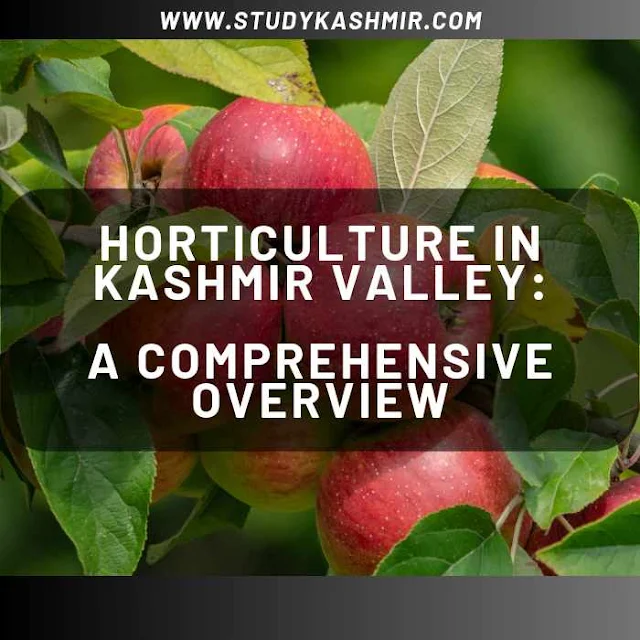Horticulture in Kashmir Valley: A Comprehensive Overview
The horticulture sector in the Kashmir Valley is a vital component of the region's economy, contributing significantly to employment, revenue, and agricultural output. With its diverse range of fruits and a favorable climate, the valley has established itself as a prominent hub for horticultural activities.
 |
Sector Overview
-
Area Under Cultivation: As of 2024-25, the total area under horticulture in Jammu and Kashmir stands at approximately 3.44 lakh hectares, marking an increase of 2,000 hectares from the previous year
-
Production Volume: The region produced around 2.64 million metric tonnes of horticultural crops in 2024, reflecting an 18.5% increase over the past three years
-
Economic Contribution: The horticulture sector contributes approximately 9% to Jammu and Kashmir's Gross State Domestic Product (GSDP)
-
Employment: The sector provides livelihoods to over 7 lakh families, underscoring its importance in the region's socio-economic fabric
Export Revenue: Kashmir’s apples are exported across India and even to foreign countries, bringing in huge revenue. The annual turnover from apple production alone is estimated at over ₹10,000 crore.
Major Horticultural Products
-
Apples Jammu and Kashmir is India's leading apple producer, accounting for about 70% of the country's total apple production
-
Walnuts and Almonds The region is responsible for 90% of India's walnut production, with significant almond cultivation as well
-
Other Fruits Pears, cherries, apricots, peaches, and plums are also cultivated extensively, adding to the valley's horticultural diversity.
-
Saffron Kashmir's Pampore region is renowned for saffron cultivation. However, production has declined from 8 metric tonnes in 2010-11 to 2.6 metric tonnes in 2023-24 due to climate change impacts
District- wise Horticultural Data
The following table provides insights into the area under horticulture, production, and yield across various districts in the Kashmir Vally:
District|Area(ha)|Produce(MT)|Yield(MT/ha) |
|-------------|-----------|-----------------|
Anantnag | 33,398 | 450,357 | 13.48 |
Baramulla | 30,061 | 498,410 | 16.58 |
Kupwara | 27,688 | 264,181 | 9.54 |
Shopian | 26,158 | 255,663 | 9.77 |
Pulwama | 23,740 | 152,350 | 6.41 |
Kulgam | 23,938 | 191,088 | 7.98 |
Budgam | 27,152 | 137,546 | 5.06 |
Ganderbal | 12,922 | 81,855 | 6.33 |
Bandipora | 7,229 | 63,565 | 8.79 |
Srinagar | 5,337 | 30,531 | 5.72 |
Note: Data represents averages over the period 2009–2019.
Key Fruit Mandis
-
*Sopore Fruit Market: Located in Nowpora Kalan Sopore, this is the largest wholesale fruit market in Kashmir and the second-largest in Asia, following Delhi's Azadpur Mandi. It handles around 40% of the apple production and sales in the regon.
-
*e-NAM Integration: Jammu and Kashmir have established 24 operational mandis, with 17 integrated into the National Agricultural Market (e-NAM) platform, facilitating electronic transactions and enhancing market efficiency.
ALSO READ: The Role of Tourism in Jammu and Kashmir Economy
ALSO READ: Traditional Art and Handicrafts of Kashmir A Cultural Treasure
Challenges Facing the Horticulture Sector
-
*Climate Change: Erratic weather patterns, including insufficient snowfall and unseasonal temperatures, have adversely affected crop cycles and yields
-
*Pest Infestations: Changing climatic conditions have led to increased pest attacks, impacting fruit quality and quantity.
-
*Infrastructure Deficits: Limited cold storage facilities and inadequate transportation infrastructure hinder the efficient distribution of produce.
-
*Market Access: Despite e-NAM integration, many farmers face challenges in accessing broader markets due to lack of awareness and digital literacy.
-
*Financial Constraints: Small and marginal farmers often lack access to credit and insurance, making them vulnerable to market and climate shocks.
Government Initiatives
-
High-Density Plantation Schem: The area under high and medium density plantations has grown from 880.89 hectares in 2020-21 to 18,533.27 hectares by November 2024, aiming to enhance productivity.
-
Infrastructure Development: Efforts are underway to improve post harvest infrastructure, including the establishment of Controlled Atmosphere (CA) storage units, to reduce post-harvest loses.
-
Skill Development: Training programs are being conducted to educate farmers on modern horticultural practices and market strategy.
In conclusion, the horticulture sector in the Kashmir Valley plays a vital role in the region's economy, providing substantial employment opportunities and contributing significantly to the Union Territory's GDP. While the sector has witnessed growth in recent years, it faces challenges that require concerted efforts from stakeholders to ensure sustainable development.